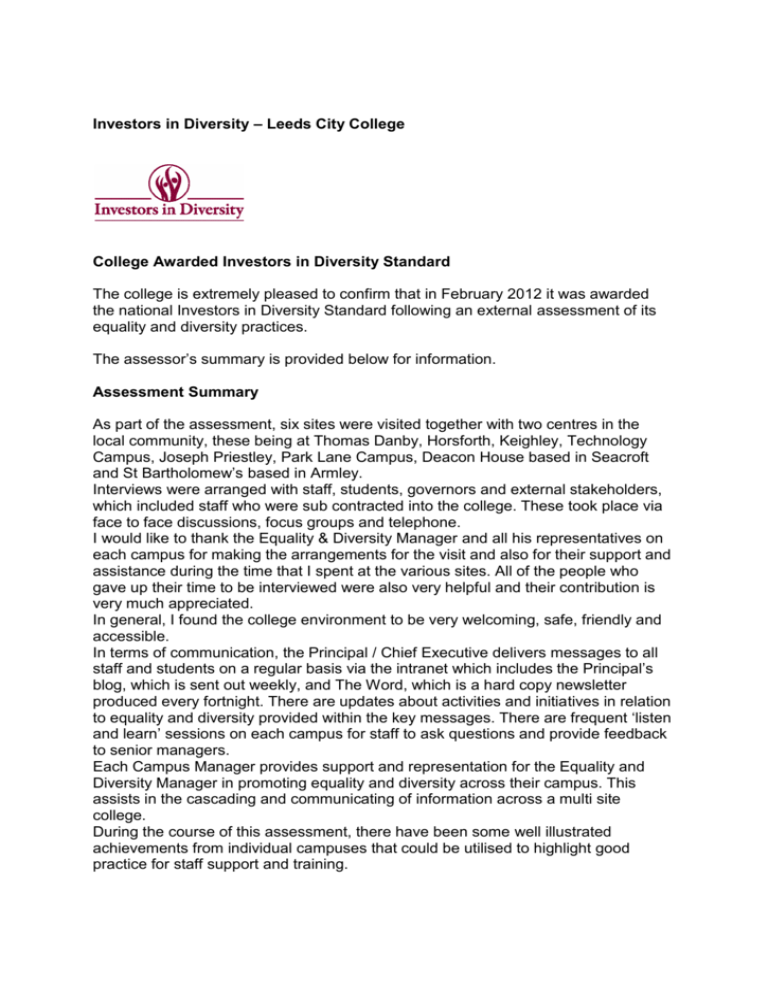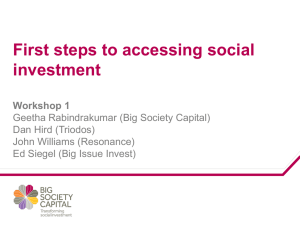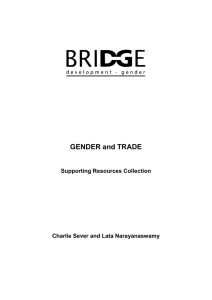Investors in Diversity and the IiD standard
advertisement

Investors in Diversity – Leeds City College College Awarded Investors in Diversity Standard The college is extremely pleased to confirm that in February 2012 it was awarded the national Investors in Diversity Standard following an external assessment of its equality and diversity practices. The assessor’s summary is provided below for information. Assessment Summary As part of the assessment, six sites were visited together with two centres in the local community, these being at Thomas Danby, Horsforth, Keighley, Technology Campus, Joseph Priestley, Park Lane Campus, Deacon House based in Seacroft and St Bartholomew’s based in Armley. Interviews were arranged with staff, students, governors and external stakeholders, which included staff who were sub contracted into the college. These took place via face to face discussions, focus groups and telephone. I would like to thank the Equality & Diversity Manager and all his representatives on each campus for making the arrangements for the visit and also for their support and assistance during the time that I spent at the various sites. All of the people who gave up their time to be interviewed were also very helpful and their contribution is very much appreciated. In general, I found the college environment to be very welcoming, safe, friendly and accessible. In terms of communication, the Principal / Chief Executive delivers messages to all staff and students on a regular basis via the intranet which includes the Principal’s blog, which is sent out weekly, and The Word, which is a hard copy newsletter produced every fortnight. There are updates about activities and initiatives in relation to equality and diversity provided within the key messages. There are frequent ‘listen and learn’ sessions on each campus for staff to ask questions and provide feedback to senior managers. Each Campus Manager provides support and representation for the Equality and Diversity Manager in promoting equality and diversity across their campus. This assists in the cascading and communicating of information across a multi site college. During the course of this assessment, there have been some well illustrated achievements from individual campuses that could be utilised to highlight good practice for staff support and training. Investors in Diversity Investors in Diversity is a national standard which helps organisations adopt and develop a set of characteristics and behaviours, which if embraced, can lead to real and sustainable gins through culture movement in organisations. It also enables organisations to measure their progress as well and receive recognition for their achievements. See www.iiduk.com The Business Case for Diversity There are various ways of formulating the ‘business case’ for addressing diversity issues. At a national level it is based on the benefits of having an ‘inclusive’ society in which there is a high level of economic independence where all sections of society can benefit from high productivity and a successful economy. At an organisational level diversity initiatives have been shown by various organisations to support business goals and objectives and enhance overall performance. As Investors in Diversity develops, we will include case studies from participating organisations in this Companion. A good source of case studies from organisations including Ford, HSBC, and B&Q, is the CIPD website – in particular a downloadable guide to managing diversity1. The assertion is that diversity initiatives designed to support business goals and objectives enhance overall business performance. This can take the form of improvements in recruitment and retention and reduced labour turnover as well as more successful products, services and customer satisfaction. Other benefits have been cited such as better decision–making, improved teamwork, greater creativity, better customer service skills and improved quality of output. The business case for managing diversity can be related to a number of aspects of business performance: Customer care and marketplace competitiveness Increasing the focus on customer care and meeting their individual needs can help to inform the development of new or enhanced products or services. Increased knowledge of and sensitivity to the diversity of customers can lead to increasing market share and a broadening of customer base. Banks, building societies, insurance companies and retailers provide examples of organisations who used diversity in this way. Products have been targeted at different groups such as professional women, gay men, or ethnic minority businesses based on knowledge of their financial and retailing requirements. Local authorities and the NHS also use knowledge of diverse groups to improve the way in which they provide services to them. Corporate image, ethics and values Being positive about diversity and including this in value statements sends a clear message to employees, customers, and other stakeholders. It communicates standards about how relationships and business should be conducted and sets the tone for good workplace behaviour, thereby minimising the possibility of damaging legal action over such things as harassment and sexual or racial discrimination. Being an employer of choice Recent surveys of graduates seeking their first employment show that salary alone is no longer the determining factor in making an employer attractive – rather the whole package of benefits including the opportunity to work flexibly. Other parts of the labour market – for example older workers - have different needs and aspirations to young people. An employer that is aware of the labour market factors and the diverse groups that make it up, is more likely to devise creative ways of attracting the talent it needs. Managing diversity is based on the premise that organisations need to get the maximum commitment from their workforce by encouraging employees and teams to make the ‘discretionary effort’ in their jobs. Employees who are valued are more likely to give that extra effort. Employers who can accommodate the different needs and aspirations of employees and potential employees by offering a range of employment packages and working arrangements can become ‘an employer of choice’. Complying with legislation Legislation reflects many of the same trends which have caused organisations to embrace diversity – increasing support for fairness, avoiding the social and economic costs of discrimination and the challenges of social, demographic and labour market changes. Non-compliance with legislation will expose organisations to the risks of expensive litigation and, perhaps more expensively, to a damaged corporate reputation and public image. Non-compliance will also have a harmful effect on the trust and loyalty of all the organisation’s stakeholders. Corporate Social Responsibility (CSR) Valuing diversity can be seen as being linked to this agenda. The argument can be set out as follows: Healthy businesses flourish in healthy societies and the needs of people, communities and businesses are interrelated. The long term growth of business markets are limited by social exclusion and low economic activity rates. Therefore, resources invested in creating successful, inclusive communities with greater choice for individuals will leverage improvements in marketplace activity. Another element of CSR is the ‘psychological contract’ between employer and employee which, if it is healthy, enables the employee to feel valued and to derive job satisfaction from their employment. This in turn influences discretionary effort and commitment which adds value to business performance. Successfully embedding and continuously improving diversity policies to create an open and inclusive culture which values everyone will generate business benefits. Conversely, neglecting the diverse needs of stakeholders will cause them to become marginalised and disengaged from the ‘psychological contract’ Part of the business case for embracing diversity is related to demographic and other statistics of which the following are examples2: Female personnel directors earn 14% less than their male colleagues More than three-quarters of male workers between 65 and 75 thought their health excellent or very good, compared with half of the unemployed men in the same age group. Eleven per cent of non-executive directors in the FTSE 100 are women. These few women are themselves outnumbered by ‘Sirs’ and ‘Lords’. The number of people aged over 60 is forecast to rise by 40% in the next 30 years Black and Asian people are 2.5 times less likely to have jobs than whites. 14% of men in households with dependent children work 60 or more hours a week. Only half of these are satisfied with their working hours. In the 10 years up to 2003, the employment of the over 50s rose by 25%. In 2003, Dame Brenda Hale was the first woman judge appointed to the House of Lords since the Magna Carta in 1215. Taken from the CIPD Guide, Managing Diversity: People make the difference at work – but everyone is different








